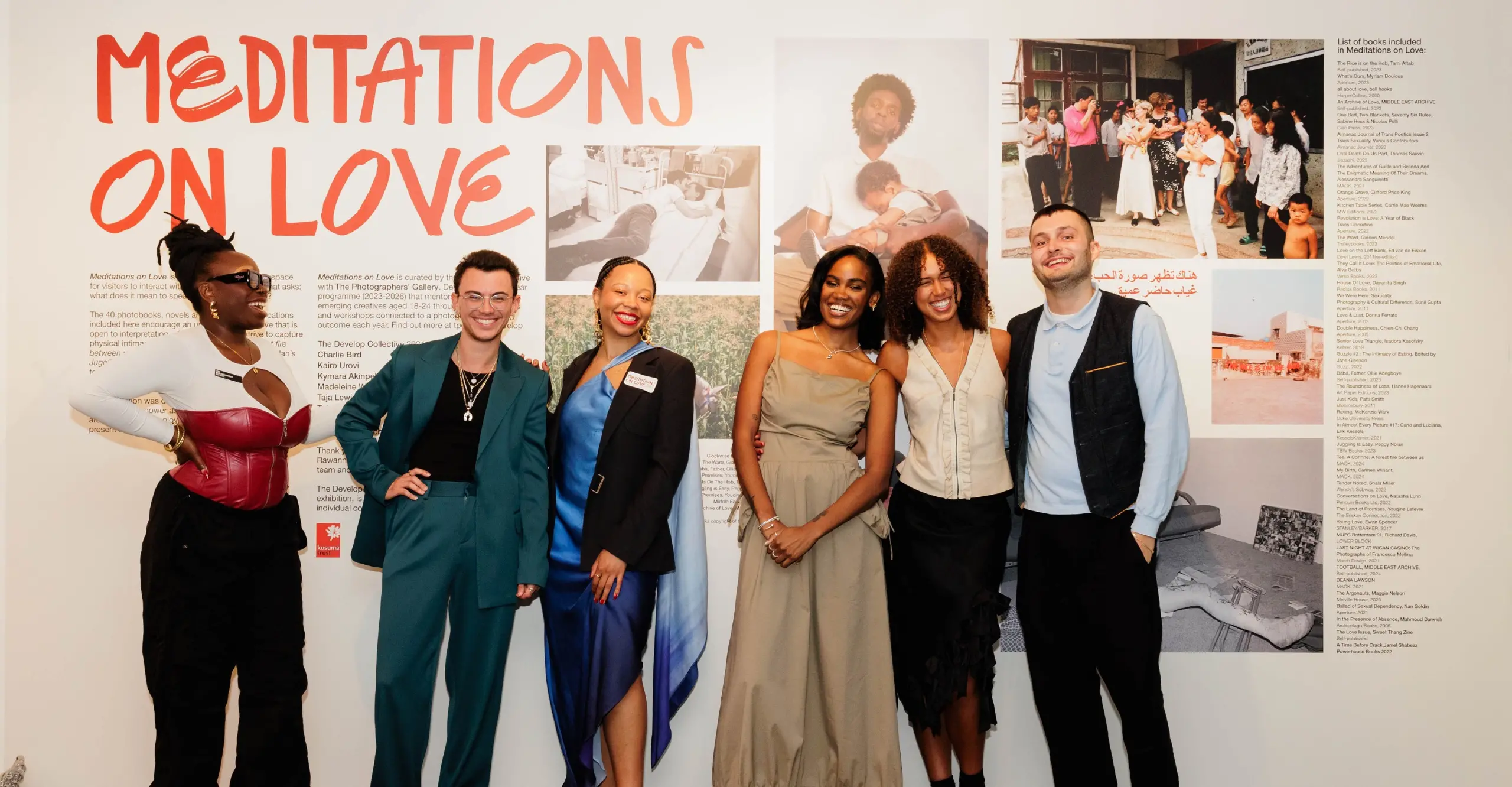Upon entering the reading room at The Photographer’s Gallery, we pass by a large mural image of father and son in puffer jackets and a cool embrace by Ollie Adegboye. Before reaching a collection of tender images on the main wall of a boy sunbathing on his donkey by Majdi Fathi and a queer couple embracing each other in a hospital bed by Gideon Mendel, among other moving scenes. The theme is clear; love. And the many books lined up the wall all hark to the exhibition’s quest to interrogate what love looks like as a subject within an archive.
Meditations on Love was curated by six young people, aged 18-24, from The Photographer’s Gallery’s Develop programme. Charlie Bird, Kairo Urovi, Kymara Akinpelumi, Madeleine Woodhouse, Taja Lewis Boodie, and Tolu Elusadé were commissioned as a collective by the Gallery to use archives as their foundation for an exhibition. The group eventually built a reading room for visitors to engage with photographic material in an accessible and intimate setting. In an attempt to disseminate a universal theme, the group were inspired by the ways in which love finds its way into all forms of art and archiving. Coupled with trips to the London College of Communication’s library and The Bishop’s Institute, the group was able to draw inspiration from a wide range of sources, both institutional and vernacular, and discussed the analogue, informal archives they keep themselves which were keepsakes of family, friends and lovers.
With a heavy focus on trans, queer, femme and POC perspectives, the group met three times a month to curate and execute the exhibition, and decided to pick six books each that reflected them to some degree, with books by Tami Aftab, Deana Lawson, Ewen Spencer, Carrie Mae Weems and the Middle East Archive, to name a few. By doing so, they wanted to challenge the formal archive, pushing the boundaries of what’s traditionally accepted and asking who has historically been excluded from institutional archives. Deliberately choosing books that go far beyond romantic love and exploring ideas around how love plays into food, architecture, and the home, for example.
Charlie, a recent Master’s graduate in Digital Culture & Society, highlights House of Love by Dayanita Singh, nine short visual stories from Delhi about the Taj Mahal as an architectural monument built from one man’s dedication to his late wife. Whereas Madeleine, an art history MA student at the University of Sussex, chooses My Birth by Carmen Winant which explores the pain that women go through as mothers and isn’t “the soft family love that we’re used to”, explains Madeleine, but shows “what mothers sacrifice to have a family”. Taja, a photographer and producer, picked out Senior Love Triangle by Isadora Kosofsky, an expression of non-monogamous elderly relationships that “get a bit left out of conversations [about love]”, and an exploration of health and sickness.
Madeleine suggested a quote by Mahmoud Darwish, the Palestinian poet, to remind us that love is also political, and our politics reflect what lies in our hearts. The interactive elements also lie in the group’s choice to include a feedback box where visitors may leave a note for someone they love. And the lampshade hanging in the room reflects the lampshade from Carrie Mae Weems’s iconic image of black motherhood almost identically.
The young people were fascinated by colloquial expressions of archiving such as family photo albums and Instagram feeds which don’t tend to be regarded with the same value as formal archives with rigid structures and academic documentation. “We wanted to tear down its colonial infrastructure and reproduce it in a different way, and in a way where the absences in these archives can be highlighted and brought to the forefront,” Madeleine explains. The group especially found the intergenerational interaction interesting, “seeing people of different ages interact with the exhibition such as elderly people with their grandchildren.”
“We can't talk about love without talking about the pain and struggles that people are going through right now,” Madeleine reminds us, referring to books in the exhibition on adoption and China’s one child policy, on divorce, and on the tragedy of the AIDS epidemic. By expanding people's definitions of love and allowing their multitude of identities and experiences to seep into their curation, Meditations on Love becomes at once a political act of community resistance by democratising the archive, as well as an introspective act, looking inward and nurturing the self. It’s an experience the group highly recommends to all young people interested in curatorial practices and the world of photography, as Taja expresses; “I would encourage anyone to apply. You learn so much. You get to work with people who may become your friendship group. You've got an exhibition in a national gallery. It's an experience that you won't be able to get elsewhere in the same capacity.”
Meditations on Love is on at The Photographer’s Gallery until 22 September 2024.
Written by Dalia Al-Dujaili


